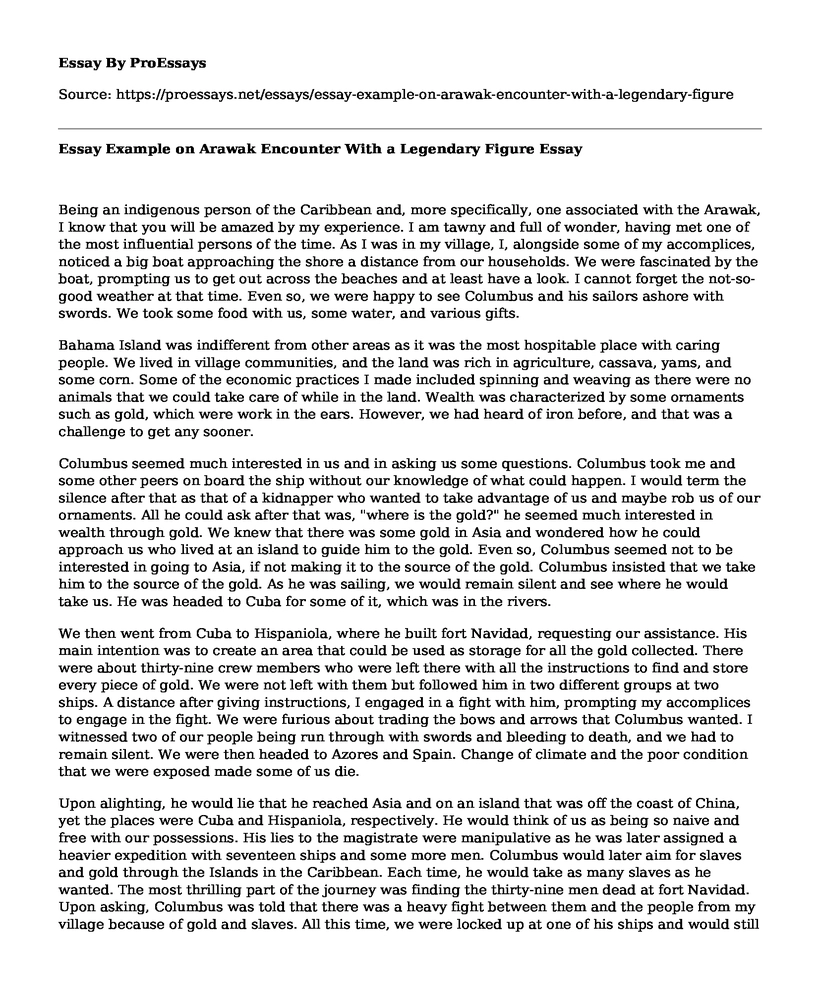Being an indigenous person of the Caribbean and, more specifically, one associated with the Arawak, I know that you will be amazed by my experience. I am tawny and full of wonder, having met one of the most influential persons of the time. As I was in my village, I, alongside some of my accomplices, noticed a big boat approaching the shore a distance from our households. We were fascinated by the boat, prompting us to get out across the beaches and at least have a look. I cannot forget the not-so-good weather at that time. Even so, we were happy to see Columbus and his sailors ashore with swords. We took some food with us, some water, and various gifts.
Bahama Island was indifferent from other areas as it was the most hospitable place with caring people. We lived in village communities, and the land was rich in agriculture, cassava, yams, and some corn. Some of the economic practices I made included spinning and weaving as there were no animals that we could take care of while in the land. Wealth was characterized by some ornaments such as gold, which were work in the ears. However, we had heard of iron before, and that was a challenge to get any sooner.
Columbus seemed much interested in us and in asking us some questions. Columbus took me and some other peers on board the ship without our knowledge of what could happen. I would term the silence after that as that of a kidnapper who wanted to take advantage of us and maybe rob us of our ornaments. All he could ask after that was, "where is the gold?" he seemed much interested in wealth through gold. We knew that there was some gold in Asia and wondered how he could approach us who lived at an island to guide him to the gold. Even so, Columbus seemed not to be interested in going to Asia, if not making it to the source of the gold. Columbus insisted that we take him to the source of the gold. As he was sailing, we would remain silent and see where he would take us. He was headed to Cuba for some of it, which was in the rivers.
We then went from Cuba to Hispaniola, where he built fort Navidad, requesting our assistance. His main intention was to create an area that could be used as storage for all the gold collected. There were about thirty-nine crew members who were left there with all the instructions to find and store every piece of gold. We were not left with them but followed him in two different groups at two ships. A distance after giving instructions, I engaged in a fight with him, prompting my accomplices to engage in the fight. We were furious about trading the bows and arrows that Columbus wanted. I witnessed two of our people being run through with swords and bleeding to death, and we had to remain silent. We were then headed to Azores and Spain. Change of climate and the poor condition that we were exposed made some of us die.
Upon alighting, he would lie that he reached Asia and on an island that was off the coast of China, yet the places were Cuba and Hispaniola, respectively. He would think of us as being so naive and free with our possessions. His lies to the magistrate were manipulative as he was later assigned a heavier expedition with seventeen ships and some more men. Columbus would later aim for slaves and gold through the Islands in the Caribbean. Each time, he would take as many slaves as he wanted. The most thrilling part of the journey was finding the thirty-nine men dead at fort Navidad. Upon asking, Columbus was told that there was a heavy fight between them and the people from my village because of gold and slaves. All this time, we were locked up at one of his ships and would still witness him sending expedition after expedition into the interior. Even though he did not find any goldfields, he still took as many slaves as he could as the expedition's power surpassed our might. This time, he did not care whether the slaves were women, children, or men. Upon his arrival in Spain, he requested the archdeacon to sell the slaves.
Some of the slaves died in captivity, and he was more interested in seeking gold to achieve his promise. Slaves were ordered to collect gold every three months in exchange for copper tokens. The task was impossible, as I also knew that it was a death trap. The only gold available consisted of bits of dust that were captured from the streams. We planned an escape, and some of us were successful in running away from captivity while others were taken down by dogs and swords. Columbus made us later face Spaniards as no gold was left to collect. While some of us escaped, some ended up in the encomienda.
Bibliography
Malott, Curry S. "The Social Construction of the Dominant Psychological Paradigm: Columbus, Slavery, and the Discourses of Domination." Critical Pedagogy and Cognition, 2011, 67-77. doi:10.1007/978-94-007-0630-9_3.
Zamora, Margarita. "Abreast of Columbus: Gender and Discovery." Cultural Critique, no. 17, (1990), 127. doi:10.2307/1354142.
Cite this page
Essay Example on Arawak Encounter With a Legendary Figure. (2023, May 03). Retrieved from https://proessays.net/essays/essay-example-on-arawak-encounter-with-a-legendary-figure
If you are the original author of this essay and no longer wish to have it published on the ProEssays website, please click below to request its removal:
- The Gilded Age Effect on American Immigrants
- Critical Thinking Example: Effects of the End of Cold War on Peacemaking
- Charles Darwin Biography Essay
- Salem Witch Trail Paper Example
- Essay Example on Clausewitz: Military Theorist, Prussian General, Hegelian Dialectician
- Essay Sample on The Industrial Revolution: 1789-1914
- Essay Sample on Race & Social Construct: W.E.B. Dubois' Color Line, Veil Theories







